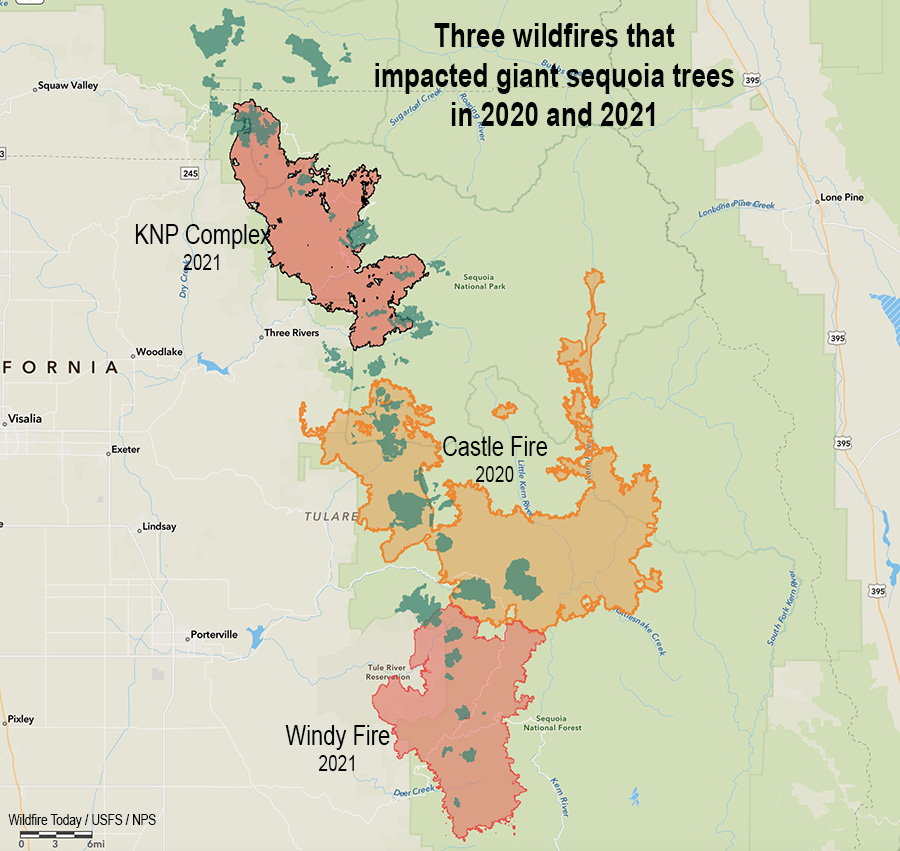
11:30 a.m. PDT Nov. 4, 2021
Giant sequoia trees can live for up to 3,000 years, but in 2020, 10 to 14 percent of all giant sequoias in the Sierra Nevada that were at least four feet diameter were killed in the Castle Fire in the Sequoia National Forest. When post-fire surveys of the 2021 fires are complete that number will probably increase substantially. It will be many months before detailed surveys are complete, but the sequoia mortality can be estimated from how severely the fire burned.
The lightning-caused 97,528-acre Windy Fire just south of the Castle Fire (see map above) burned into eleven giant sequoia groves in September and October, 2021. The Forest Service is working to determine the impacts of the fire in the groves managed by the Forest Service. The agency said on November 2 that initial assessments based on observations by resource advisors and burn severity analysis indicate the fire killed hundreds of giant sequoias. Many more were heavily torched and may or may not survive.
A report released June 25, 2021 about the 2020 Castle Fire found that areas which burned with high intensity killed many giant sequoias. The data showed 97.3 percent mortality of the trees in high fire severity areas, and 55.1 percent in moderate severity locations.
Preliminary fire severity data is now available for a portion of one of the two 2021 fires that burned through groves of giant sequoias, in this case, Giant Sequoia National Monument in the Windy Fire.

Using the fire severity data for the portion of the Windy Fire in Giant Sequoia National Monument, if there was only one giant sequoia per acre before the fire, approximately 1,142 were likely killed. However, there were probably far more than one per acre.
While numerous fires were burning in 2021 in California there was a shortage of firefighters due to unfilled positions in the US Forest Service, COVID-19 restrictions keeping some on the sidelines, and competition for resources among the fires. The limited numbers that were available worked on suppressing the spread of the fires, and on the Windy and KNP Complex they also took actions to protect the huge sequoias as personnel were available.

In some areas, they constructed firelines surrounding a grove or individual groups of trees, set up sprinkler systems, and removed ladder fuels from around individual trees in advance of the fire. After the fire burned through, additional efforts were made to further reduce the fire’s impact on giant sequoia trees by extinguishing hot spots in and around the trees, again, as personnel were available.
The US Forest Service said that from initial observations, it was apparent that giant sequoia trees treated before the Windy Fire swept through were more likely to survive. Those with duff and woody debris scraped away from their trunks, especially near burn marks, were less susceptible in most cases. In the Starvation Complex grove, four out of six giant sequoia trees treated before the fire reached them, survived. An estimated 116 trees not accessible before the fire, were killed. Similar conditions were found in the Long Meadow Grove, where more than a decade of fuels reduction efforts helped save the giant sequoia trees along the Trail of 100 Giants.
“Within the high severity burned areas, most of the giant sequoias were burned and killed,” said Forest Ecosystem Manager Gretchen Fitzgerald. “In moderate severity areas, some giant sequoias may survive while those in low severity burned areas are likely to survive the Windy Fire.”
The Sequoia National Forest will be partnering with researchers and local experts to monitor the groves and determine the impacts of the Windy and Castle Fires over the next year.
“Recent fires highlight the need for restoration in the giant sequoia groves,” stated Forest Supervisor Teresa Benson. “By reducing fuels through prescribed burning and other density-reduction treatments, the likelihood of future large, high-severity fires can be reduced. The Giant Sequoia National Monument Management Plan requires protection, preservation, and restoration of giant sequoias through management activities. We will continue to work with our partners, Tule River Indian Reservation, National Park Service, Save the Redwoods League, and CAL FIRE on best management practices to protect and restore our giant sequoia groves.”










